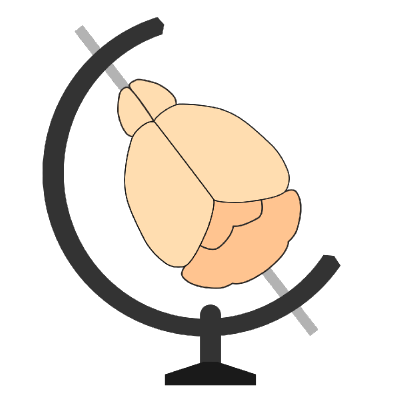Registering data#
To get the most out of brainrender, your data should be registered to one of the atlases supported by the BrainGlobe Atlas API. If you’ve used BrainGlobe’s software for processing your raw data (e.g. brainreg) your data will already be registered, and you need not worry about any of this. If not, then some steps are necessary for registering your data.
Hint
This section assumes that your data were registered to an atlas already, but they are currently in a different orientation or resolution to the atlas you are intending to use. If that is not the case, you register your data first (e.g. with brainreg).
Please note that although software tools like brainreg make it increasingly easy to register anatomical data to atlases, this is still a not-trivial steps in the analysis of any anatomical data.
Aligning to atlas’s space#
Brainglobe’s Atlas API relies on brainglobe-space for transforming data (e.g. image stacks) so that they are all oriented the same way. brainglobe-space provides a convenient naming convection to define the orientation of your data based on where the origin is and the direction that the three main axes (first three dimensions of your image data) point towards.
The process of transforming data from one axes system requires knowing the “space” of your target (i.e. of brainrender’s atlas data) and of the source (your data). The orientation of your data depends on your experimental set-up and subsequent pre-processing steps. To know what brainrender’s target space is:
from brainrender import Scene
scene = Scene()
print(scene.atlas.space)
"""
<BGSpace AnatomicalSpace object>
origin: ('Anterior', 'Superior', 'Right')
sections: ('Frontal plane', 'Horizontal plane', 'Sagittal plane')
shape: (528, 320, 456)
"""
Check the brainglobe-space documentation) for more details.
Matching resolution and offset#
The section above described how to sort your image axes to that the coordinates order matches brainrender’s. However, you might need additional steps to ensure that your data are registered to the atlases: your data might be at a different resolution or to a different offset. Resolution refers to how many microns (all units in brainrender are in microns) the side of the voxels in your image correspond to. Offset refers to the fact that the origin of your image might be offset from the origin of the atlas space (e.g. if you didn’t image the entire brain).
Here too brainglobe-space provides tools to address mismatches in these two aspects.
